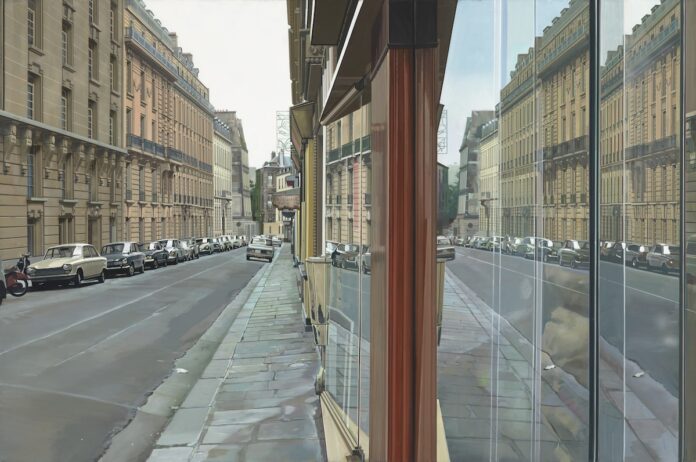The work of Richard Estes, who is 91, is no longer, as they say, “part of the conversation.” But when he came to prominence in the late 1960s, his paintings seemed instantly canonical. He was the most dazzling, and the most quietly oracular, of the photorealists — painters who imitated the look of photographs. Silently, austerely, his work seemed to prophesy a future state in which photography would colonize the immanent world and illusions overtake reality.
Estes studied fine arts at the School of the Art Institute of Chicago in the early 1950s before moving to New York, where he worked as a graphic designer for magazines and advertising agencies. In his spare time, he started painting shop fronts, diners and signage, using photographs as sources.
Relishing the tension between transparency and opacity, he came to specialize in the gleaming interface between the scuffed sidewalk and the corporate headquarters — all those mirror reflections that turn the rational grid of Manhattan (think of Mondrian’s “Broadway Boogie-Woogie”) into a funhouse of optical reverb: glass, chrome, glossy car hoods.
Garry Winogrand used to say he took photographs to find out what things looked like photographed. The statement, as an expression of artistic motive, sounds unhelpful, until you register what wacky things photographs do to things we think we know — how almost nonchalantly they mug the mind’s prejudices.
What’s the rationale, then, behind paintings of photographs? To see what photographs look like painted? Not exactly.
Estes painted the kinds of things street photographers like Winogrand and Lee Friedlander loved to photograph. But where Winogrand and Friedlander used their cameras to capture the city’s high-speed, off-kilter energy, Estes had Apollonian impulses. He wanted to soothe the city, slow it down. Drawn to symmetry, order and silence, he brought the Tuscan clarity and Platonic geometries of Piero della Francesca to late-20th-century Gotham.
This painting, which hangs in the Virginia Museum of Fine Art in Richmond, is at once characteristic of Estes and very unusual. It’s typical in its symmetry, reflections and deep perspective lines. It’s rare because instead of New York, it shows Paris.
Paris on a gray day, when light is harmonized with its absence and nothing dares to be so crass as to flash. There’s something hypnotic here about the contrast between the adamantine, light-absorbing stone of the buildings and the languidly understated reflections that come off the parked cars (I spy a couple of Citroens!). Solid and permanent meets insubstantial and illusory — and voilà! They all hit it off.
Get up close and you see it’s all dun-colored paint applied in discreet patches of subtly altered hue and tone. Estes deftly marries the warp of sharp outlines to the weft of the wobbly mirage. Note the sunspots and cloudy smears in the lower half of the window at right. You might also see the car parked across the street from the others; Estes signed his name on its license plate.
Photographs are indiscriminate. They show everything that falls within the frame, including those things the mind habitually factors out: light switches, shopping lists, dust, clutter. It was precisely this unselective objectivity, and the almost surreal poetry it tapped into, that fascinated postwar street photographers.
Estes, by contrast, was all about intention. He was super-selective. Around the time he made this painting, he had begun using multiple photographs as sources for each painting, often combining perspectives into a new, synthetic image. He was ruthless about what he omitted.
But on the other hand, he appears to have relished the confusion that reflections create. In urban settings especially, reflections force the mind to intervene more actively in basic vision, to winnow what is illusory from what is real. They reintroduced complexity to the order Estes craved.



